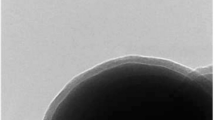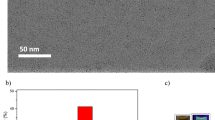Abstract
Silica mesochannels (SMCs) vertically and regularly oriented to the surface of indium tin oxide (ITO) electrodes were prepared and utilized for preconcentration and detection of methylene blue (MB) in aqueous solution. The positively charged MB can be adsorbed to the SMCs by following the pseudo-first-order kinetic model. The negative value of ΔG=−34.73 kJ/mol derived from the Langmuir adsorption isotherm indicated the thermodynamic feasibility of the adsorption and the spontaneous nature of the process. Moreover, the adsorbed MB can undergo an electrochemical reaction on the ITO electrode at a suitable potential and the resulting electrical current can be utilized to quantify the MB in aqueous solution. A good analytical performance for MB with a linear range from 10 nmol/L to 1.0 μmol/L and a detection limit at the nmol/L level was obtained. We believe that such a platform consisting of SMCs perpendicularly tethered to the underlying electrode surface simultaneously allows enrichment and electrochemical detection and can be extended for the detection of various charged dyes, as well as many other charged species.
Similar content being viewed by others

References
Sheng J, Xie Y, Zhou Y. Adsorption of methylene blue from aqueous solution on pyrophyllite. Appl Clay Sci, 2009, 46: 422–424
Robinson T, McMullan G, Marchant R, Nigam P. Remediation of dyes in textile effluent: a critical review on current treatment technologies with a proposed alternative. Bioresour Technol, 2001, 77: 247–255
Crini G. Non-conventional low-cost adsorbents for dye removal: a review. Bioresour Technol, 2006, 97: 1061–1085
Pinheiro HM, Touraud E, Thomas O. Aromatic amines from azo dye reduction: status review with emphasis on direct UV spectrophotometric detection in textile industry wastewaters. Dyes Pigm, 2004, 61: 121–139
Riu J, Schönsee I, Barceló D, Ràfols C. Determination of sulphonated azo dyes in water and wastewater. TrAC, Trends Anal Chem, 1997, 16: 405–419
Walker GM, Weatherley LR. Adsorption of dyes from aqueous solution: the effect of adsorbent pore size distribution and dye aggregation. Chem Eng J, 2001, 83: 201–206
Geçgel Ü, Özcan G, Gürpınar GÇ. Removal of methylene blue from aqueous solution by activated carbon prepared from pea shells (Pisum sativum). J Chem, 2012, 2013: 1–9
Ho KY, McKay G, Yeung KL. Selective adsorbents from ordered mesoporous silica. Langmuir, 2003, 19: 3019–3024
Zubieta C, Sierra MB, Morini MA, Schulz PC, Albertengo L, Rodriguez MS. The adsorption of dyes used in the textile industry on mesoporous materials. Colloid Polym Sci, 2008, 286: 377–384
Cestari AR, Vieira EFS, Vieira GS, da Costa LP, Tavares AMG, Loh W, Airoldi C. The removal of reactive dyes from aqueous solutions using chemically modified mesoporous silica in the presence of anionic surfactant. The temperature dependence and a thermodynamic multivariate analysis. J Hazard Mater, 2009, 161: 307–316
Anbia M, Salehi S. Removal of acid dyes from aqueous media by adsorption onto amino-functionalized nanoporous silica SBA-3. Dyes Pigm, 2012, 94: 1–9
Chen Z, Zhou L, Zhang F, Yu C, Wei Z. Multicarboxylic hyperbranched polyglycerol modified SBA-15 for the adsorption of cationic dyes and copper ions from aqueous media. Appl Surf Sci, 2012, 258: 5291–5298
Wang C, Tao S, Meng C. Facile fabrication of magnetic mesoporous silica via multifunctional surfactant self-assembly and oxidation. J Mater Chem, 2012, 22: 7179–7186
Qu Q, Gu Z. Facile synthesis of hierarchical MCM-41 spheres with an ultrahigh surface area and their application for removal of methylene blue from aqueous solutions. Anal Methods, 2014, 6: 1397–1403
Rehman F, Volpe PLO, Airoldi C. Free amino and imino-bridged centres attached to organic chains bonded to structurally ordered silica for dye removal from aqueous solution. J Environ Manage, 2014, 133: 135–143
Wang H-N, Liu F-H, Wang X-L, Shao K-Z, Su Z-M. Three neutral metal-organic frameworks with micro- and meso-pores for adsorption and separation of dyes. J Mater Chem A, 2013, 1: 13060–13063
He X, Male KB, Nesterenko PN, Brabazon D, Paull B, Luong JHT. Adsorption and desorption of methylene blue on porous carbon monoliths and nanocrystalline cellulose. ACS Appl Mater Interfaces, 2013, 5: 8796–8804
Zhang B, Liu B, Liao J, Chen G, Tang D. Novel electrochemical immunoassay for quantitative monitoring of biotoxin using target-responsive cargo release from mesoporous silica nanocontainers. Anal Chem, 2013, 85: 9245–9252
Lin C, Wu Y, Luo F, Chen D, Chen X. A label-free electrochemical DNA sensor using methylene blue as redox indicator based on an exonuclease III-aided target recycling strategy. Biosens Bioelectron, 2014, 59: 365–369
Liu T, Li Y, Du Q, Sun J, Jiao Y, Yang G, Wang Z, Xia Y, Zhang W, Wang K, Zhu H, Wu D. Adsorption of methylene blue from aqueous solution by graphene. Colloids Surf B, 2012, 90: 197–203
Özer A, Dursun G. Removal of methylene blue from aqueous solution by dehydrated wheat bran carbon. J Hazard Mater, 2007, 146: 262–269
Feng M, You W, Wu Z, Chen Q, Zhan H. Mildly alkaline preparation and methylene blue adsorption capacity of hierarchical flower-like sodium titanate. ACS Appl Mater Interfaces, 2013, 5: 12654–12662
Gillman PK. Methylene blue implicated in potentially fatal serotonin toxicity. Anaesthesia, 2006, 61: 1013–1014
Ramsay RR, Dunford C, Gillman PK. Methylene blue and serotonin toxicity: inhibition of monoamine oxidase A (MAO A) confirms a theoretical prediction. Br J Pharmacol, 2007, 152: 946–951
Borwitzky H, Haefeli WE, Burhenne J. Analysis of methylene blue in human urine by capillary electrophoresis. J Chromatogr B, 2005, 826: 244–251
Tang D, Santschi PH. Sensitive determination of dissolved sulfide in estuarine water by solid-phase extraction and high-performance liquid chromatography of methylene blue. J Chromatogr A, 2000, 883: 305–309
Kim S-J, Ha D-J, Koo T-S. Simultaneous quantification of methylene blue and its major metabolite, azure B, in plasma by LC-MS/MS and its application for a pharmacokinetic study. Biomed Chromatogr, 2014, 28: 518–524
Bélaz-David N, Decosterd LA, Appenzeller M, Ruetsch YA, Chioléro R, Buclin T, Biollaz J. Spectrophotometric determination of methylene blue in biological fluids after ion-pair extraction and evidence of its adsorption on plastic polymers. Eur J Pharm Sci, 1997, 5: 335–345
Wang S, Lv S, Guo Z, Jiang F. Solid-phase microextraction of methylene blue using carboxy graphene-modified steel wires, and its detection by electrochemiluminescence. Microchim Acta, 2014, 181: 427–433
Meynen V, Cool P, Vansant EF. Verified syntheses of mesoporous materials. Microporous Mesoporous Mat, 2009, 125: 170–223
Moscofian ASO, Pires CTGVMT, Vieira AP, Airoldi C. Removal of reactive dyes using organofunctionalized mesoporous silicas. J Porous Mater, 2013, 20: 1179–1188
Corma A. From microporous to mesoporous molecular sieve materials and their use in catalysis. Chem Rev, 1997, 97: 2373–2420
Zhao XS, Lu GQ, Hu X. Characterization of the structural and surface properties of chemically modified MCM-41 material. Microporous Mesoporous Mat, 2000, 41: 37–47
Huo Q, Margolese DI, Stucky GD. Surfactant control of phases in the synthesis of mesoporous silica-based materials. Chem Mater, 1996, 8: 1147–1160
Guillemin Y, Etienne M, Aubert E, Walcarius A. Electrogeneration of highly methylated mesoporous silica thin films with vertically-aligned mesochannels and electrochemical monitoring of mass transport issues. J Mater Chem, 2010, 20: 6799–6807
Teng Z, Zheng G, Dou Y, Li W, Mou C-Y, Zhang X, Asiri AM, Zhao D. Highly ordered mesoporous silica films with perpendicular mesochannels by a simple Stöber-solution growth approach. Angew Chem Int Ed, 2012, 51: 2173–2177
Jiang X, Bastakoti BP, Weng W, Higuchi T, Oveisi H, Suzuki N, Chen W-J, Huang Y-T, Yamauchi Y. Preparation of ordered mesoporous alumina-doped titania films with high thermal stability and their application to high-speed passive-matrix electrochromic displays. Chem Eur J, 2013, 19: 10958–10964
Wu KCW, Jiang X, Yamauchi Y. New trend on mesoporous films: precise controls of one-dimensional (1D) mesochannels toward innovative applications. J Mater Chem, 2011, 21: 8934–8939
Walcarius A, Sibottier E, Etienne M, Ghanbaja J. Electrochemically assisted self-assembly of mesoporous silica thin films. Nat Mater, 2007, 6: 602–608
Etienne M, Quach A, Grosso D, Nicole L, Sanchez C, Walcarius A. Molecular transport into mesostructured silica thin films: electrochemical monitoring and comparison between P6m, P63/mmc, and Pm3n structures. Chem Mater, 2007, 19: 844–856
Lagergren S. About the theory of so-called adsorption of soluble substances. Kungl Svenska Vetenskapsakad Handl, 1898, 24: 1–39
Langmuir I. The constitution and fundamental properties of solids and liquids. Part I. Solids. J Am Chem Soc, 1916, 38: 2221–2295
Author information
Authors and Affiliations
Corresponding author
Rights and permissions
About this article
Cite this article
He, Y., Ding, L. & Su, B. Vertically ordered silica mesochannels as preconcentration materials for the electrochemical detection of methylene blue. Sci. China Chem. 58, 1593–1599 (2015). https://doi.org/10.1007/s11426-015-5365-2
Received:
Accepted:
Published:
Issue Date:
DOI: https://doi.org/10.1007/s11426-015-5365-2



